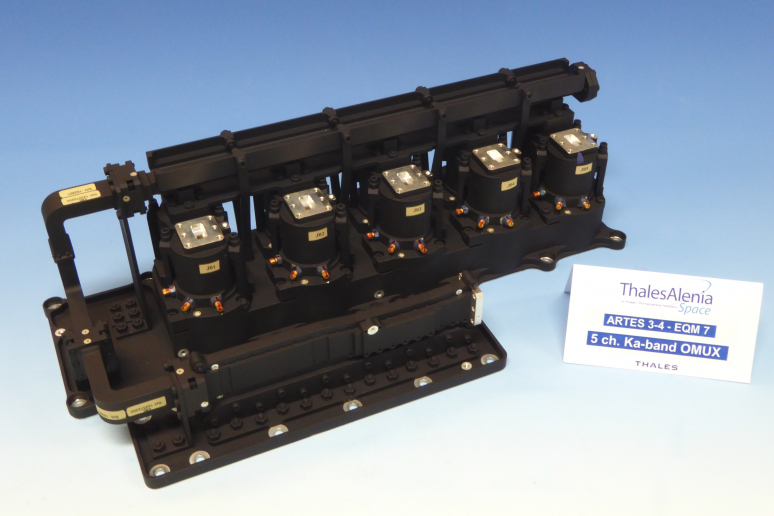-
StatusOngoing
-
Status date2018-10-30
-
Activity Code5C.212
The purpose of the Project is to qualify a five-channels fully thermally compensated output Multiplexer (OMUX) for high power Ka-Band telecommunications applications. The main topics of the development are : New Ka-Band Channel Filter - four poles – narrow band including a thermal compensation device New Ka-Band Manifold including a thermal compensation device. New Ka-Band high Power Low Pass Filter. The study and all analysis are performed on a twelve Channels OMUX in Ka frequency band [19.7 GHZ – 20.2 GHz] with 340 W. as input power per Channel. The qualification is performed on a five Channels OMUX

The main challenges, based on THALES ALENIA SPACE IN FRANCE Ku and Ka band TC OMUX background, are to demonstrate:
- High Power capability
- Competitive RF performances
- Competitive Thermal design and Mass
This development allows THALES ALENIA SPACE IN FRANCE to offer better payload solutions according to the use of more performing and more compact output Filters. The advantages of the Ka-band fully Thermally Compensated OMUX solution are particularly significant for the incoming generation of high power payloads using the latest generation of high power TWT’s (170 W.). Furthermore these TWT’s can be paired in one channel, leading to an RF power of up to 340 W. per channel. This new product offers a very high RF power capability compared to potential existing competitor systems.
The Ka-band fully Thermally Compensated OMUX is composed of :
- Aluminium 4 poles channels Filters. The compact design of the lateral coupling between the 2 cavities of the channels contributes to reduce the footprint and the mass. This RF solution allows also to optimize the thermal design and to increase the input power per channel. A great stability of the centre frequency in temperature is ensured thanks to a suitable thermal compensation device attached on each channel Filter
- Aluminium Manifold with thermal compensation is designed in order to be compatible to a very high input power, keeping a good thermal stability for RF performances.
- Aluminium high power Low Pass Filter is designed in order to achieve input power without Multipactor event, and required far out of band rejections.
The OMUX development is organized in three phases:
Phase 1 – Numerical simulations and Breadboards testing
- Band-Pass Filter RF design analysis and synthesis,
- RF Trade-off between TE114 mode and TE115 mode
- RF design of a 4 poles Filter
- TE114 mode and lateral topology.
- RF design of the Low Pass Filter
- Study and mechanical / thermal design of the TC Filter
- Study and mechanical / thermal design of the TC Manifold
- Breadboards Test Plan definition.
- OMUX PDR
Band-Pass Filter, Low-Pass Filter and Manifold preliminary design
- Breadboards Band-Pass Filters, Manifold and Low-Pass Filter Definition Files and manufacturing
- Multipactor tests on Breadboard Low-Pass Filter
- Vibrations, Shocks, Life tests on Breadboard Band-Pass Filters
- Life tests on Breadboard Manifold - OMUX RF, mechanical and thermal study.OMUX final design
- OMUX CDR
Final Band-Pass Filter, final Low-Pass-Filter and Manifold design. Breadboards Band-Pass Filter, Low-Pass-Filter and Manifold tests results.
Phase 2 – OMUX Manufacturing, mounting and testing :
- OMUX Definition files - OMUX Manufacturing, assembling, tuning, pre-acceptance tests
- Tests procedures
- OMUX TRR
Phase 3 – Qualification tests:
- OMUX Full qualification tests sequence
- Final Review
Development Plan summary:
The initial Qualification test sequence has been stopped due to a first issue occurred during the Power handing tests, and a second issue occurred during the Thermal vacuum tests. The EQM OMUX has been reworked after having introduced a slight improvement on the compensation device of the channel Filters and remanufactured all the cavities After rework and all along the pre-acceptance tests, the channel Filters thermal compensation was checked and the measurements were in line with expected. The new Qualification test sequence including Power handing test, Vibrations test, Shocks test, Thermal Vacuum test, EMC test and final control, is completed. Significant achievements of the Project : The Ka-Band EQM full TC OMUX has successfully completed the qualifications tests :
- Power Handing tests: Successful with 340 W. input power, in TVAC conditions at Fc (+90°C), and OOB Frequency (+85°C). Thermal measurements are consistent with the thermal predictions, no degradation or evolution of the RF performances observed after the application of power at central frequency and in out of band case. • Vibrations and Shocks tests : Levels applied cover a large Platforms envelope : NEOSAT, EUROSTAR, ALPHABUS, INVAP, ISS EXPRESS, DFH4 Low RF frequency drift after Vibrations and Shocks Tests • Thermal Vacuum tests under qualification temperature range including self-heating (-10°C/+109°C) successful Excellent stability of the central frequency function of the temperature effect : 0.8 ppm/°C over the qualification temperature range [+15°C/+85°C], better than CTE of invar technology.
- EMC tests, more than 19 dB margin.
- RF full performances along the qualifications tests : Very high RF performances stability between initial and final test, cumulated Frequency drift average is close to 0.35 MHz
- Breadboards Channels Filters : Vibrations tests and Shocks tests successful Life test successful • Breadboard Manifold with thermal compensation Life tests successful
- Breadboard Low Pass Filter : Multipactor test successful, up to 6000 W
Initial objectives of the Project have been fulfilled :
- High power capability,
- competitive RF performances,
- competitive thermal design and Mass.
All the developments related to the Project are completed:
- Ka-band Channel Filter - four poles – narrow band, with thermal compensation device
- Ka-band Manifold with thermal compensation device.
- Ka-band High power Low-Pass Filter
- Full TC High power Ka-band OMUX.



